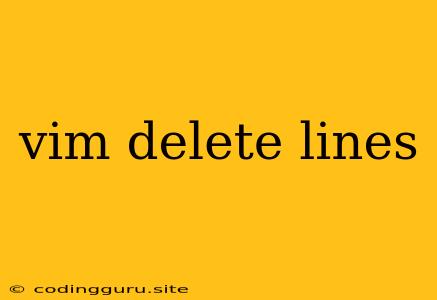Vim Delete Lines: A Comprehensive Guide
Vim is a powerful and highly customizable text editor, known for its efficiency and versatility. One of the essential skills in Vim is the ability to delete lines of code quickly and effectively. This guide will delve into the various methods for deleting lines in Vim, equipping you with the tools to navigate your editing tasks with confidence.
The Basics of Vim Line Deletion
Before we explore the different commands, it's crucial to understand the fundamental concept of line-oriented editing in Vim. When working with Vim, you are essentially interacting with lines of text rather than individual characters. This approach allows for efficient navigation and manipulation of large amounts of code.
The dd Command: Your Go-To for Single Line Deletion
The dd command is the most basic and straightforward method for deleting lines in Vim. Simply place your cursor on the line you wish to remove and type dd. This will delete the entire line, including any whitespace or indentation.
Example:
This is line 1.
This is line 2.
This is line 3.
After placing your cursor on line 2 and typing dd, the following result will appear:
This is line 1.
This is line 3.
Deleting Multiple Lines: The Power of d and Number Prefixes
For deleting multiple lines, Vim provides a convenient way to use numerical prefixes with the d command. You can specify the number of lines to delete by typing a number followed by d.
Example:
To delete the next three lines, type 3d.
Example:
This is line 1.
This is line 2.
This is line 3.
This is line 4.
This is line 5.
After placing your cursor on line 1 and typing 3d, the following result will appear:
This is line 1.
This is line 5.
Deleting Lines from the Current Line to the End of the File
Sometimes, you might want to remove all the lines from the current line until the end of the file. To achieve this, use the dG command. This command deletes from the current line to the last line of the file.
Example:
This is line 1.
This is line 2.
This is line 3.
This is line 4.
This is line 5.
After placing your cursor on line 2 and typing dG, the following result will appear:
This is line 1.
Deleting Lines Using Visual Mode
Visual mode in Vim offers a powerful way to select and delete lines with precision. Enter visual mode by pressing v. Then use the arrow keys to highlight the lines you want to delete. Once the desired lines are selected, type d to delete them.
Example:
This is line 1.
This is line 2.
This is line 3.
This is line 4.
This is line 5.
After pressing v, move your cursor to highlight lines 2 and 3. Then type d to delete those lines.
Deleting Lines with the :d Command
For more advanced line deletion, the :d command is your friend. It allows you to specify line numbers or ranges to delete lines precisely.
Example:
To delete lines 2 to 4, type :2,4d.
Example:
This is line 1.
This is line 2.
This is line 3.
This is line 4.
This is line 5.
After typing :2,4d, the following result will appear:
This is line 1.
This is line 5.
Beyond Basic Deletion: Exploring More Advanced Techniques
While dd, d, and :d are essential for line deletion, Vim offers a variety of advanced techniques. These include:
Dcommand: Deletes from the cursor position to the end of the current line.Jcommand: Joins the current line with the next line.xcommand: Deletes the character under the cursor.Xcommand: Deletes the character before the cursor.scommand: Substitutes the current character with the next input.
Tips for Efficient Line Deletion in Vim
- Use the
.command to repeat your last action. This saves time when you need to perform the same deletion multiple times. - Combine line deletion with other Vim commands. For example, you can use
ddto delete a line and thenpto paste it elsewhere. - Practice using visual mode. It gives you precise control over which lines you delete.
Conclusion
Mastering line deletion in Vim is fundamental to becoming a proficient user. By understanding the different commands and techniques, you can efficiently manage your code and text files, enhancing your productivity significantly. Remember to practice these techniques regularly, and you'll be on your way to becoming a true Vim expert.
